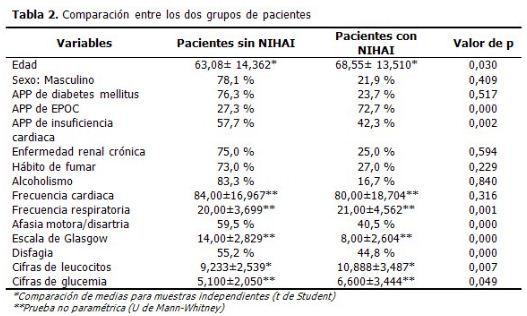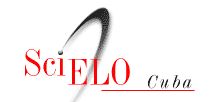
Predictores clínicos de neumonía intrahospitalaria asociada al ictus isquémico agudo
Resumen
Objetivo: identificar los predictores clínicos de neumonía asociada al ictus isquémico agudo.
Método: se estudiaron 201 pacientes pertenecientes a una cohorte prospectiva de estudio con el diagnóstico de ictus isquémico agudo, admitidos de modo consecutivo en la sala de ictus, del Hospital General Universitario Carlos Manuel de Céspedes durante los primeros 7 días a partir de su inicio, desde enero del 2012 hasta diciembre 2013. Los predictores independientes de neumonía intrahospitalaria se obtuvieron usando regresión logística multivariable.
Resultados: el 56,7 % eran del sexo masculino, la media de edad fue 64,17± 14,33 años. La totalidad de casos con neumonía intrahospitalaria asociada al ictus fue de un 19, 9 %. Los sujetos que desarrollaron neumonía tenían más edad (68,55± 13,51 vs. 63,08± 14,36 años), tuvieron menor puntuación en la escala de Glasgow (8,00±2,60 vs. 14,00±2,82), y mayor cifras de leucocitos al ingreso (10,888±3,487 vs. 9,233±2,539× 109/l). Se identificaron los siguientes factores independientes: escala de Glasgow ≤ 11 (OR: 26,099; IC 95 % 7,164- 85,075), historia de enfermedad pulmonar obstructiva crónica (OR: 8,896; IC 95 % 1,203-65,779), disfagia (OR: 7,652; IC 95 % 2,369- 24,720), antecedentes de insuficiencia cardiaca (OR: 4,583; IC 95 % 1,240- 16,932), disartria/afasia motora severa (OR: 4,222; IC 95 % 1,374- 12,975).
Conclusiones: el modelo de regresión logística resultante es un instrumento válido para predecir neumonía postictus basado en los datos disponibles de forma rutinaria.
Palabras clave
Referencias
Carnesoltas L, Serra MA, O’Farrill R. Factores de riesgo y mortalidad por neumonía intrahospitalaria en la Unidad de Terapia Intensiva de Ictus. Medwave. 2013;13(2):1-9.
Yapeng l, Bo S, Hui F, Yuan G, Lu Z, Yusheng L, et al. Risk factors for stroke-associated pneumonia in a chinese population: a prospective cohort study. Life Sci J. 2014;11(6):378-82.
Langhorne P, Stott DJ, Robertson L, MacDonald J, Jones L, McAlpine C, et al. Medical complications after stroke: a multicenter study. Stroke. 2000;31(6):1223-9.
Finlayson O, Kapral M, Hall R, Asllani E, Selchen D, Saposnik G. Risk factors inpatient care, and outcomes of pneumonia after ischemic stroke. Neurology. 2011;77(14):1338-45.
Harms H, Grittner U, Droge H, Meisel A. Predicting post-stroke pneumonia: the PANTHERIS score. Acta Neurol Scand. 2013;128(3):178-84.
Forti P, Maioli F, Procaccianti G, Nativio V, Lega MV, Coveri M, et al. Independent predictors of ischemic stroke in the elderly: prospective data from a stroke unit. Neurology. 2013;80(1):29-38.
Ji R, Shen H, Pan Y, Wang P, Liu G, Wang Y, et al. Novel risk score to predict pneumonia after acute ischemic stroke. Stroke. 2013;44(5):1303-9.
Sellars C, Bowie L, Bagg J, Sweeney MP, Miller H, Tilston J, et al. Risk factors for chest infection in acute stroke: a prospective cohort study. Stroke. 2007;38(8):2284-91.
Koennecke HC, Belz W, Berfelde D, Endres M, Fitzek S, Hamilton F, et al. Factors influencing in-hospital mortality and morbidity in patients treated on a stroke unit. Neurology. 2011;77(10): 965-72.
Brämer D, Hoyer H, Günther A, Nowack S, Brunkhorst FM, Witte OW, et al. Study protocol: prediction of stroke associated infections by markers of autonomic control. BMC Neurology. 2014;14(9):1-6.
Folyovich A, Biró E, Orbán C, Bajnok A, Varga V, Béres AK, et al. Relevance of novel inflammatory markers in stroke-induced immunosuppression. BMC Neurology. 2014;14(41):1-7.
Winklewski PJ, Radkowski M, Demkow U. Cross-talk between the inflammatory response, sympathetic activation and pulmonary infection in the ischemic stroke. J Neuroinflammation. 2014;11(1):213.
De Raedt S, De Vos A, Van Binst AM, De Waele M, Coomans D, Buyl R, et al. High natural killer cell number might identify stroke patients at risk of developing infections. Neurol Neuroimmunol Neuroinflamm. 2015;2(2):71.
García E, Hernández A, Herrero JA, Gómez J. Protocolo terapéutico empírico de la neumonía nosocomial. Medicine. 2014;11(56):3330-2.
Buergo MA, Concepción O, Pérez J, Pando A. Guías de práctica clínica. Enfermedad cerebrovascular. La Habana:ECIMED;2009.
Mazumdar M, Glassman JR. Categorizing a prognostic variable: review of methods, code for easy implementation and applications to decision making about cancer treatments. Stat Med. 2000;19(1):113-32.
Chen LF, Chang CY, Hsu LC, Tsai PH, Chang SJ, Chang SC, et al. Bacterial pneumonia following acute ischemic stroke. J Chin Med Assoc. 2013;76(2):78-82.
Liesz A, Dalpke A, Mracsko E, Antoine DJ, Roth S, Zhou W, et al. DAMP signaling is a key pathway inducing immune modulation after brain injury. J Neurosci. 2015;35(2):583–98.
Ji R, Wang D, Shen H, Pan Y, Liu G, Wang P, et al. Interrelationship among common medical complications after acute stroke: pneumonia plays an important role. Stroke. 2013;44(12):3436-44.
Li Y, Song B, Fang H, Gao Y, Zhao L, Xu Y. External validation of the A2DS2 score to predict stroke-associated pneumonia in a chinese population: a prospective cohort study. Plos One. 2014;9(10):1-6.
Zhang X, Wang F, Zhang Y, Ge Z. Risk factors for developing pneumonia in patients with diabetes mellitus following acute ischaemic stroke. J Int Med Res. 2012;40(5):1860-5.
Arboix A, Masson J, García L, Targa C, Oliveres M. Clinical predictors of prolonged hospital stay after acute stroke: relevance of medical complications. IJCM. 2012;3(1):502-7.
Akkoyunlu Y, Öztoprak N, Aydemir H, Pişkin N, Çelebi G, Ankarali H, et al. Risk factors for nosocomial pneumonia in intensive care units of a University Hospital. JMID. 2013;3(1):3-7.
Enlaces refback
- No hay ningún enlace refback.
FINLAY EN: 








FINLAY CERTIFICADA POR:

Esta revista "no aplica" cargos por publicación en ninguna etapa del proceso editorial.
Dirección postal: Calle 51A y Avenida 5 de Septiembre Cienfuegos, Cuba Código postal: 55100.
http://www.revfinlay.sld.cu
Telefono: +53 43 516602. Telefax: +53 43 517733.
amgiraldoni@infomed.sld.cu
ISSN: 2221-2434
RNPS: 5129






